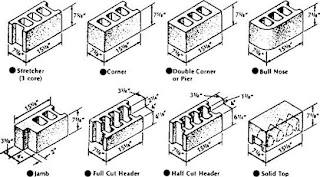
Keep in mind that there will be a natural variation in the color of the CMUs, even if they come from the same manufacturing batch. This allows for the block and mortar to blend together or to have a sharp contrast. Pigments can be added to both the concrete block as well as the mortar. Be sure to meet with your local CMU representative to learn about what types of finishes they offer and at what cost premium. The images below cover the most common shapes, but you should check with your local CMU manufacturer if you need special shapes or finishes.Ĭomes in various sizes Concrete Masonry Unit (CMU) Surface FinishesĪs with shapes, there are a large number of finish options so you can make the utilitarian gray concrete block look much more aesthetically pleasing. There are an almost infinite number of CMU shapes available. Prefaced Concrete and Calcium Silicate Masonry Units ASTM DESIGNATIONĬMUs for construction of Catch Basins and Manholes ASTM C90 covers most conventional CMU construction and is the standard referenced by the ICC codes. The following table provides the ASTM standards that apply to concrete masonry units. Architects must specify the CMU weight if a particular weight is required. Heavier units tend to reduce sound transmission, have much higher compressive strengths, and have greater thermal storage capacity however, they are more expensive and cost more to install. Lighter CMUs are less expensive, require less labor to install, and tend to have better fire resistance properties. There are three classifications of CMU: lightweight (less than 105 lb/ft 3), medium weight (between 105 lb/ft 3 and 125 lb/ft, and normal weight (more than 125 lb/ft 3. The weight of concrete masonry units varies depending on the density of concrete mix used. The standards identify appropriate materials, compressive strength, dimensional tolerance, moisture absorption, and other performance characteristics.Ĭoncrete brick is made from concrete similar to concrete block, but concrete bricks are fabricated in sizes that match traditional clay bricks (i.e. CMU SIZEĬoncrete Masonry Unit (CMU) SpecificationsĬMU manufacturers must conform to ASTM standards when fabricating concrete blocks.

While 4", 6", 8", 10", and 12" are the standard sizes, some manufacturers offer other sizes not listed below. The following table provides concrete block sizes in both nominal and actual dimensions. The architect should always attempt to design buildings using the nominal dimensions to the nearest half-block size to reduce waste and labor due to cut blocks. For instance, a 6" CMU is nominally 6" deep while a 10" CMU is nominally 10" deep.Ĭoncrete blocks also come in half-sizes, which are helpful in reducing the need to cut blocks in the field at corners or the end of walls. They are identified by their depth – i.e. We recommend you view current product samples before making your final selection.Concrete Block - Nominal vs Actual Dimensions Concrete Block (CMU) SizesĬoncrete Masonry Units (CMUs) are manufactured in a variety of sizes. The product images on this page provide a general indication of colour to assist with your selection. We deliver for a wide range of industry leading manufacturers.

We deliver to depots in Toowoomba and Brisbane for freight forwarding across Australia. We deliver across South-East Queensland using Dantrans, our purpose-built fleet of trucks with all-terrain forklifts.
BREEZE BLOCK DIMENSIONS FREE
Orders of $500 and over delivered free to Toowoomba, Highfields, Westbrook and within 26 kms of Toowoomba.

Phone us NOW at Darling Downs Brick Sales on 07 4633 3311 or email for your best Delivered quote. With 38 years experience in the industry we are the experts in building and landscape supplies. Please contact us on 07 4633 3311 before purchasing if you are unsure which Concrete Block best suits your project. Coloured Sea Breeze Blocks 2NDs 390x140x190mm (Glacier)Ĭhoosing the right Concrete Block is important!īefore selecting, you should ensure this product meets your projects requirements.


 0 kommentar(er)
0 kommentar(er)
